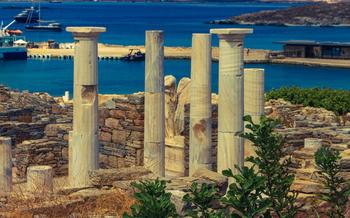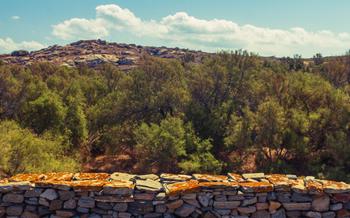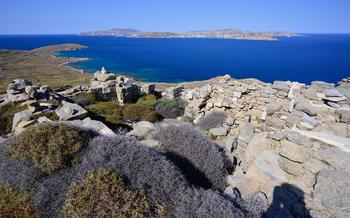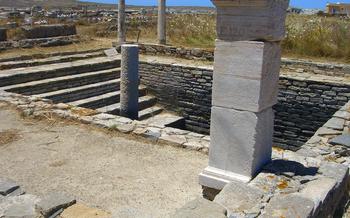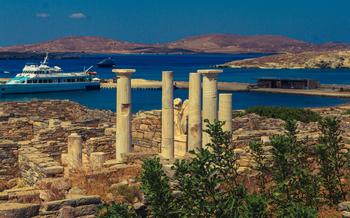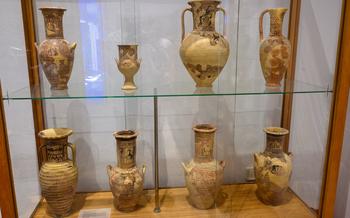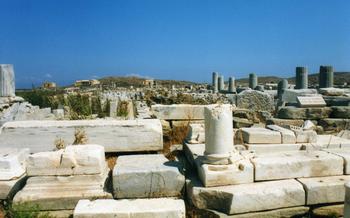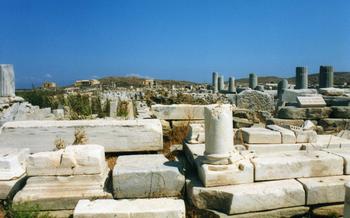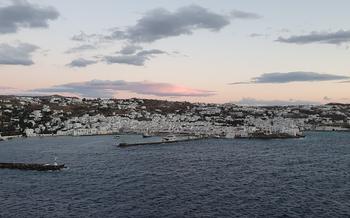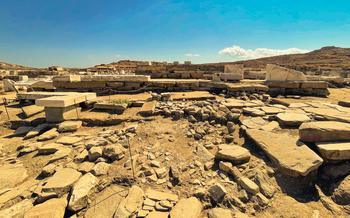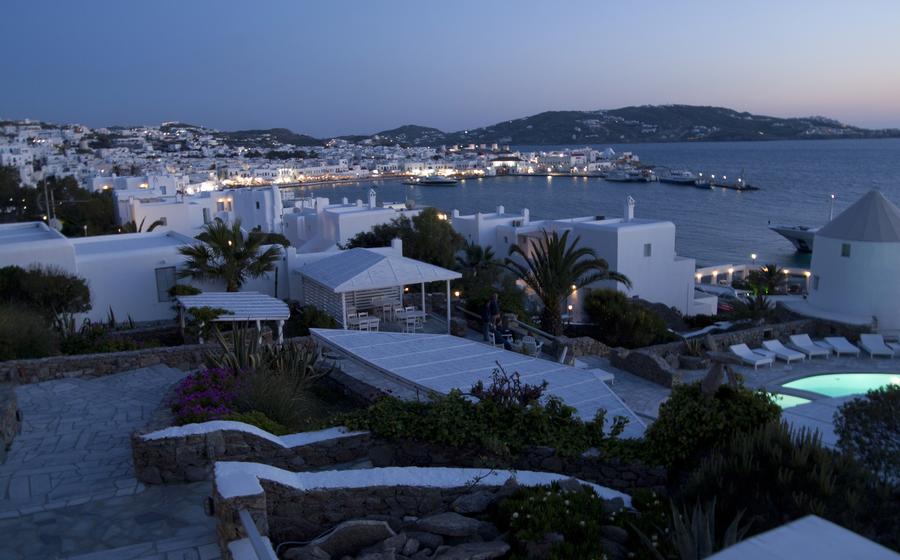
Church of Saint George at Delos
- Delos: An Ancient Sanctuary Unveiled
- Exploring the Church of Saint George at Delos
- Getting to Delos: A Ferry Odyssey
- Unveiling the Archaeological Museum of Delos
- The Ancient Agora: Delos' Marketplace
- The House of Dionysus: A Glimpse into Ancient Luxury
- The Terrace of the Lions: Majestic Guardians
- The Sacred Lake: A Place of Ritual Purification
- Mount Kynthos: Delos' Highest Peak
- The Theater of Delos: Ancient Performances
- The Necropolis: Delos' City of the Dead
- The Archaeological Site: A Living Museum
- Insider Tip: Early Bird Magic
Delos: An Ancient Sanctuary Unveiled
Delos, a small island nestled in the heart of the Aegean Sea, holds a profound significance in Greek mythology and history. Renowned as the birthplace of the gods Apollo and Artemis, Delos served as a sacred sanctuary and a thriving religious center in antiquity. Its strategic location fostered its role as a prosperous commercial hub, attracting traders and pilgrims from across the Mediterranean. The island's rich past, steeped in mythology and maritime trade, has left behind a remarkable legacy of ancient ruins, unearthed through meticulous archaeological excavations. Today, Delos stands as a UNESCO World Heritage Site, inviting visitors to embark on a journey through time and discover the captivating remnants of a once-glorious civilization.
Exploring the Church of Saint George at Delos
The Church of Saint George at Delos stands as a testament to the island's rich cultural heritage, blending Byzantine architectural elements with the sacred history of Delos. Built in the 11th century AD, the church is a unique example of early Christian architecture in the Cyclades. Its modest exterior belies an intricate interior adorned with frescoes and mosaics that depict scenes from the life of Saint George and other religious figures.
The church's construction coincided with the decline of the ancient city of Delos, as the island's religious significance waned and its population dwindled. However, the church's presence suggests that Delos continued to be a place of pilgrimage and worship, even after its ancient glory had faded.
The frescoes and mosaics within the church are particularly noteworthy. They showcase the artistic skills of the Byzantine era, with vibrant colors and expressive figures. The central dome of the church features a depiction of Christ Pantocrator, surrounded by angels and saints. Other frescoes depict scenes from the Bible, including the Annunciation, the Nativity, and the Crucifixion.
The Church of Saint George is a poignant reminder of Delos' transition from a bustling ancient metropolis to a tranquil island with a rich Christian history. It invites visitors to delve into the island's complex past and appreciate the enduring legacy of faith and devotion that has shaped Delos over the centuries.
Getting to Delos: A Ferry Odyssey
To reach the ancient island of Delos from the vibrant shores of Mykonos, a ferry odyssey awaits. Several ferry companies offer regular services, providing a scenic and convenient mode of transportation. Ferries depart from the picturesque port of Mykonos Town, inviting you on a journey through the shimmering Aegean waters. The crossing typically takes between 30 to 45 minutes, allowing you to soak in the breathtaking views of the surrounding islands and the vastness of the open sea.
For those seeking a flexible itinerary, there are multiple ferry departures throughout the day, ensuring a hassle-free trip. Whether you prefer a morning excursion or an afternoon exploration, options are available to suit your preferences. The cost of a return ticket ranges from 20 to 30 euros, offering great value for an unforgettable experience.
To avoid the peak tourist season crowds, consider planning your visit outside of July and August, when the island tends to be less crowded. This will allow you to fully appreciate the tranquility and magic of Delos without the hustle and bustle of large groups. Embark on this ferry odyssey to Delos and let the allure of ancient ruins and captivating history sweep you away.
Unveiling the Archaeological Museum of Delos
Discovering the Treasures of Antiquity
Nestled amidst the archaeological wonders of Delos, the Archaeological Museum stands as a treasure trove of ancient artifacts that narrate the island's rich history. Step into its hallowed halls and embark on a journey through time, where intricate sculptures, delicate pottery, and gleaming jewelry whisper tales of a bygone era.
The museum's collection is a testament to Delos' profound significance as a religious and commercial center. Gaze upon exquisite marble statues that once adorned temples and sanctuaries, capturing the essence of ancient Greek artistry. Marvel at the intricately painted pottery, each piece a canvas for mythological scenes and everyday life. Admire the delicate craftsmanship of gold and silver jewelry, worn by Delos' elite as symbols of wealth and status.
Located conveniently within the archaeological site, the museum provides a sanctuary of knowledge and preservation. Its exhibits offer invaluable insights into the daily lives, religious beliefs, and artistic expressions of the ancient Delians. Immerse yourself in the stories etched into each artifact, and let the museum transport you back to the vibrant world of ancient Greece.
Practical Information:
-
Location: The Archaeological Museum of Delos is situated within the archaeological site of Delos, a short walk from the ferry dock.
-
Accessibility: The museum is wheelchair accessible, with ramps and elevators providing easy access to all exhibits.
-
Admission Fees: The entrance fee to the museum is included in the general admission ticket for the archaeological site of Delos.
The Ancient Agora: Delos' Marketplace
In the heart of ancient Delos, bustling with commercial activity, stood the Agora, a vibrant marketplace that served as the economic hub of the city. Excavations have unearthed the remains of shops, warehouses, and public buildings, offering a glimpse into the daily life and trade that once thrived within these walls.
Among the excavated structures, visitors can explore the ruins of shops selling a variety of goods, from pottery and jewelry to imported luxuries. These shops catered to the diverse needs of Delos' cosmopolitan population, which included merchants, sailors, and pilgrims from across the Mediterranean.
In addition to commercial activities, the Agora also served as a social and political center. Public buildings, such as the Bouleuterion (council chamber) and the Prytaneion (government building), were located within the Agora, indicating its importance in the city's governance.
Artifacts discovered in the Agora provide valuable insights into the economic and social dynamics of ancient Delos. Coins, weights, and measures reveal the sophisticated systems of trade and commerce that operated on the island. Inscriptions record transactions, contracts, and laws, shedding light on the legal and administrative aspects of daily life.
Exploring the ancient Agora of Delos is a journey through time, transporting visitors back to an era of bustling trade, lively interactions, and the vibrant spirit of this ancient metropolis.
The House of Dionysus: A Glimpse into Ancient Luxury
At the heart of Delos, nestled amidst the archaeological ruins, stands the House of Dionysus, a testament to the opulence and sophistication of ancient Greek life. This private residence, dating back to the 2nd century BC, offers a rare glimpse into the lavish lifestyle of the island's wealthy elite.
The house's most striking feature is its intricate mosaics, which depict scenes from Greek mythology with remarkable detail and artistry. These colorful mosaics adorn the floors and walls, creating a vibrant and immersive experience for visitors. One particularly notable mosaic portrays Dionysus, the god of wine and revelry, surrounded by his entourage of satyrs and maenads.
Beyond its mosaics, the House of Dionysus showcases exquisite architecture and design elements. The peristyle courtyard, surrounded by graceful columns, provides a serene and inviting space for relaxation and entertainment. The rooms are adorned with frescoes and decorative moldings, reflecting the refined taste of its ancient owners.
The House of Dionysus serves as a poignant reminder of the social hierarchy that existed in ancient Delos. The opulence and grandeur of this private residence stand in stark contrast to the more modest dwellings of ordinary citizens. It highlights the significant disparities in wealth and status that characterized ancient Greek society.
Exploring the House of Dionysus is akin to stepping back in time, immersing oneself in the world of ancient elites. It offers a glimpse into their luxurious lifestyle, their artistic sensibilities, and their deep connection to the gods.
The Terrace of the Lions: Majestic Guardians
Location and Description:
Situated atop a hill overlooking the archaeological site of Delos, the Terrace of the Lions is an awe-inspiring sight. This ancient terrace features a row of nine imposing marble lions, each standing approximately 5 meters tall. Their majestic presence and intricate carvings instantly captivate visitors, transporting them back to a time of ancient grandeur. The lions are arranged in two rows, facing each other, as if guarding the sacred precinct of Apollo.
Symbolism and Significance:
In ancient Greek culture, lions held profound symbolic significance. They were associated with strength, courage, and protection. As guardians of the sacred precinct, the lions served as protectors of the island and its sacred treasures. Their imposing presence symbolized the might and majesty of the gods, particularly Apollo, the patron deity of Delos.
Historical Context:
The Terrace of the Lions was constructed in the 7th century BC, during the reign of the Naxian tyrant Lygdamis. It is believed that the lions were originally part of a larger ensemble of statues that adorned the terrace. Over time, many of these statues were lost or destroyed, leaving only the lions to stand as silent witnesses to Delos' rich history.
Role of the Lions:
The Terrace of the Lions served several important functions in ancient Delos. It acted as a sacred boundary, marking the separation between the sacred precinct of Apollo and the rest of the island. The lions also served as a symbolic gateway, welcoming visitors and pilgrims as they entered the sacred space. Their protective presence reassured the faithful that they were under the watchful gaze of the gods.
The Sacred Lake: A Place of Ritual Purification
Nestled amidst the ancient ruins of Delos, the Sacred Lake holds a unique and profound significance in the island's religious history. This natural freshwater lake served as a vital site for ritual purification in ancient Greek culture. Believed to possess sacred properties, the lake played a central role in religious ceremonies, rituals, and purification rites.
According to mythology, Leto, the mother of Apollo and Artemis, sought refuge on Delos after being pursued by the wrathful goddess Hera. Exhausted and in labor, Leto found solace and sanctuary by the Sacred Lake, where she gave birth to her divine twins. This mythical association imbued the lake with an aura of sanctity, making it a revered site for worshippers and pilgrims.
In ancient times, individuals seeking purification would immerse themselves in the lake's waters, believing that it cleansed them of impurities and sins. The lake's proximity to the Temple of Apollo further enhanced its religious significance, as worshippers would perform purification rituals before entering the sacred precinct.
Today, the Sacred Lake remains a poignant reminder of Delos' rich religious heritage. Although the lake's water level has fluctuated over the centuries and its appearance has changed, its spiritual essence endures. Visitors can still marvel at this tranquil body of water and contemplate its profound role in ancient religious practices.
Mount Kynthos: Delos' Highest Peak
Ascend the slopes of Mount Kynthos, Delos' commanding peak, and discover a realm of breathtaking panoramas and ancient history. Towering over the island, this majestic mountain invites you to embark on a journey through time, revealing the secrets of Delos' past.
Delve into the heart of the archaeological site and uncover the remnants of ancient fortifications, silent witnesses to the island's strategic importance. Explore the ruins of a temple dedicated to Zeus, the king of the gods, and immerse yourself in the myths and legends that once resonated within these sacred walls.
From the summit of Mount Kynthos, let your gaze wander across the shimmering expanse of the Aegean Sea, dotted with neighboring islands that seem to float upon the horizon like scattered jewels. The panoramic views from this vantage point are simply breathtaking, offering a perspective that will forever etch itself into your memory.
Whether you choose to ascend the mountain on foot, following ancient paths that wind their way through the rugged terrain, or opt for a more leisurely journey by vehicle, the rewards are equally enchanting. The vistas that unfold before you are a testament to the enduring beauty and historical significance of Delos, an island that continues to captivate visitors with its timeless allure.
The Theater of Delos: Ancient Performances
Nestled amidst the ancient ruins of Delos, the well-preserved theater stands as a testament to the island's rich cultural and artistic heritage. Constructed in the 3rd century BC, the theater played a pivotal role in religious festivals and performances that celebrated the glory of Apollo, the patron deity of Delos.
With a seating capacity of approximately 5,500 spectators, the theater's design reflects the architectural ingenuity of the ancient Greeks. The carefully crafted tiers of marble seats rise in a semicircular formation, ensuring excellent acoustics and unobstructed views of the stage. The stage itself, once adorned with elaborate Bühnenbilder, provided a platform for theatrical performances, musical concerts, and poetry recitals.
The theater's historical significance extends beyond its architectural beauty. It served as a sacred space where religious dramas and rituals were performed, honoring Apollo and other deities. During the annual Delian Festival, the theater came alive with the sounds of music, dance, and theatrical productions that celebrated the island's mythological origins and its role as a sacred sanctuary.
Today, the Theater of Delos stands as a silent witness to a bygone era, its grandeur and opulence preserved in stone. Visitors can still feel the palpable sense of awe and wonder that permeated the theater during ancient times, imagining the vibrant performances that once graced its stage.
The Necropolis: Delos' City of the Dead
Beyond the bustling streets of ancient Delos, a somber realm unfolds—the necropolis, a vast city of the dead. Situated outside the city walls, this sprawling cemetery bears witness to the final resting places of Delos' inhabitants. As you traverse the necropolis, you'll encounter a diverse array of tombs and burial structures, each whispering tales of ancient funerary customs.
Simple graves, marked by unadorned stone slabs, lie side by side with elaborate mausoleums, their facades intricately carved with scenes from mythology and daily life. Step inside one of these grand tombs, and you'll be transported back in time, surrounded by the echoes of ancient mourners and the scent of funerary offerings.
Artifacts and inscriptions found within the tombs provide invaluable insights into the beliefs and practices of the ancient Delians. Epitaphs, etched in stone, immortalize the names and virtues of the deceased, while funerary objects, such as pottery, jewelry, and coins, offer glimpses into their earthly possessions and hopes for the afterlife.
The necropolis is not merely a place of mourning but also a testament to Delos' changing population and social structure. As the city grew in wealth and prominence, so too did the size and grandeur of its tombs. The elaborate mausoleums and lavish offerings reflect the desire of the wealthy and powerful to secure a place of honor in the afterlife, even as death beckoned.
As you wander through the necropolis, let your imagination soar and picture the processions of mourners who once tread these paths, bearing their loved ones to their final resting place. Reflect on the lives they lived, the stories they carried, and the enduring legacy they left behind in this ancient city of the dead.
The Archaeological Site: A Living Museum
Delos is not merely a collection of ancient ruins but a living museum that continues to reveal its secrets through ongoing excavations. Archaeologists have meticulously unearthed the remains of temples, theaters, houses, and other structures, providing invaluable insights into the island's rich past. The ongoing excavations not only expand our understanding of ancient Delos but also contribute to the preservation and protection of this significant cultural heritage site.
However, managing and maintaining the extensive archaeological site presents several challenges. The harsh Mediterranean climate, coupled with the influx of visitors, can contribute to the deterioration of the ancient ruins. Striking a balance between preserving the site's integrity and providing access for tourists is a delicate task. Sustainable tourism practices, such as limiting visitor numbers and implementing strict regulations, are crucial to ensuring the long-term preservation of Delos.
Despite the challenges, the archaeological site of Delos remains a testament to the enduring legacy of ancient Greece. Visitors can wander among the ruins, imagining the bustling streets, vibrant markets, and religious ceremonies that once took place here. Delos offers a unique opportunity to connect with the past and gain a deeper understanding of the civilization that shaped the course of Western history.
Insider Tip: Early Bird Magic
For an unforgettable experience at Delos, consider visiting early in the morning, before the crowds descend upon the island. The tranquility of the site during these hours is truly magical, allowing you to fully immerse yourself in the history and beauty of this ancient sanctuary.
Roaming through the ruins bathed in the soft morning light, you'll feel as though you've stepped back in time. Capture stunning photographs without the throngs of tourists in the background, letting the ancient stones and serene atmosphere take center stage.
Embrace the opportunity to connect with Delos on a deeper level, free from the distractions of busy crowds. Indulge in the island's natural beauty, marveling at the intricate details of the ruins and the breathtaking views of the Aegean Sea.
By becoming an early bird explorer of Delos, you'll not only avoid the midday heat but also gain a unique and deeply personal appreciation for this sacred island.
